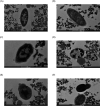Inactivation Kinetics and Membrane Potential of Pathogens in Soybean Curd Subjected to Pulsed Ohmic Heating Depending on Applied Voltage and Duty Ratio
- PMID: 32385086
- PMCID: PMC7357481
- DOI: 10.1128/AEM.00656-20
Inactivation Kinetics and Membrane Potential of Pathogens in Soybean Curd Subjected to Pulsed Ohmic Heating Depending on Applied Voltage and Duty Ratio
Abstract
The aim of this research was to investigate the efficacy of the duty ratio and applied voltage in the inactivation of pathogens in soybean curd by pulsed ohmic heating (POH). The heating rate of soybean curd increased rapidly as the applied voltage increased, although the duty ratio did not affect the temperature profile. We supported this result by verifying that electrical conductivity increased with the applied voltage. Escherichia coli O157:H7, Salmonella enterica serovar Typhimurium, and Listeria monocytogenes in soybean curd were significantly (P < 0.05) inactivated by more than 1 log unit at 80 Vrms (root mean square voltage). To elucidate the mechanism underlying these results, the membrane potential of the pathogens was examined using DiBAC4(3) [bis-(1,3-dibutylbarbituric acid)trimethine oxonol] on the basis of a previous study showing that the electric field generated by ohmic heating affected the membrane potential of cells. The values of DiBAC4(3) accumulation increased under increasing applied voltage, and they were significantly (P < 0.05) higher at 80 Vrms, while the duty ratio had no effect. In addition, morphological analysis via transmission electron microscopy showed that electroporation and expulsion of intracellular materials were predominant at 80 Vrms Moreover, electrode corrosion was overcome by the POH technique, and the textural and color properties of soybean curd were preserved. These results substantiate the idea that the applied voltage has a profound effect on the microbial inactivation of POH as a consequence of not only the thermal effect, but also the nonthermal effect, of the electric field, whereas the duty ratio does not have such an effect.IMPORTANCE High-water-activity food products, such as soybean curd, are vulnerable to microbial contamination, which causes fatal foodborne diseases and food spoilage. Inactivating microorganisms inside food is difficult because the transfer of thermal energy is slower inside than it is outside the food. POH is an adequate sterilization technique because of its rapid and uniform heating without causing electrode corrosion. To elucidate the electrical factors associated with POH performance in the inactivation of pathogens, the effects of the applied voltage and duty ratio on POH were investigated. In this study, we verified that a high applied voltage (80 Vrms) at a duty ratio of 0.1 caused thermal and nonthermal effects on pathogens that led to an approximately 4-log-unit reduction in a significantly short time. Therefore, the results of this research corroborate database predictions of the inactivation efficiency of POH based on pathogen control strategy modeling.
Keywords: Applied voltage; duty ratio; electrode corrosion; membrane potential; pulsed ohmic heating; soybean curd.
Copyright © 2020 American Society for Microbiology.
Figures







Similar articles
-
Investigation of optimum ohmic heating conditions for inactivation of Escherichia coli O157:H7, Salmonella enterica serovar Typhimurium, and Listeria monocytogenes in apple juice.BMC Microbiol. 2017 May 19;17(1):117. doi: 10.1186/s12866-017-1029-z. BMC Microbiol. 2017. PMID: 28525985 Free PMC article.
-
Effect of continuous ohmic heating to inactivate Escherichia coli O157:H7, Salmonella Typhimurium and Listeria monocytogenes in orange juice and tomato juice.J Appl Microbiol. 2012 Apr;112(4):723-31. doi: 10.1111/j.1365-2672.2012.05247.x. Epub 2012 Feb 20. J Appl Microbiol. 2012. PMID: 22292508
-
Effect of milk fat content on the performance of ohmic heating for inactivation of Escherichia coli O157:H7, Salmonella enterica Serovar Typhimurium and Listeria monocytogenes.J Appl Microbiol. 2015 Aug;119(2):475-86. doi: 10.1111/jam.12867. Epub 2015 Jun 25. J Appl Microbiol. 2015. PMID: 26043029
-
Inactivation of Microorganisms in Foods by Ohmic Heating: A Review.J Food Prot. 2018 Jul;81(7):1093-1107. doi: 10.4315/0362-028X.JFP-17-343. J Food Prot. 2018. PMID: 29905088 Review.
-
Microbial decontamination assisted by ultrasound-based processing technologies in food and model systems: A review.Compr Rev Food Sci Food Saf. 2023 Jul;22(4):2802-2849. doi: 10.1111/1541-4337.13163. Epub 2023 May 15. Compr Rev Food Sci Food Saf. 2023. PMID: 37184058 Review.
Cited by
-
Effects of the Marinating Process on the Quality Characteristics and Bacterial Community of Leisure Dried Tofu.Foods. 2023 Feb 16;12(4):841. doi: 10.3390/foods12040841. Foods. 2023. PMID: 36832916 Free PMC article.
-
Modeling of mold inactivation via cold atmospheric plasma (CAP).Appl Environ Microbiol. 2025 May 21;91(5):e0210224. doi: 10.1128/aem.02102-24. Epub 2025 Apr 4. Appl Environ Microbiol. 2025. PMID: 40183547 Free PMC article.
References
-
- Nguyen HN, Miyagawa N, Miura K, Okuda N, Yoshita K, Arai Y, Nakagawa H, Sakata K, Ojima T, Kadota A, Takashima N, Fujiyoshi A, Ohkubo T, Abbott RD, Okamura T, Okayama A, Ueshima H. 2018. Dietary tofu intake and long-term risk of death from stroke in a general population. Clin Nutr 37:182–188. doi:10.1016/j.clnu.2016.11.021. - DOI - PubMed
Publication types
MeSH terms
LinkOut - more resources
Full Text Sources
Molecular Biology Databases
Miscellaneous

